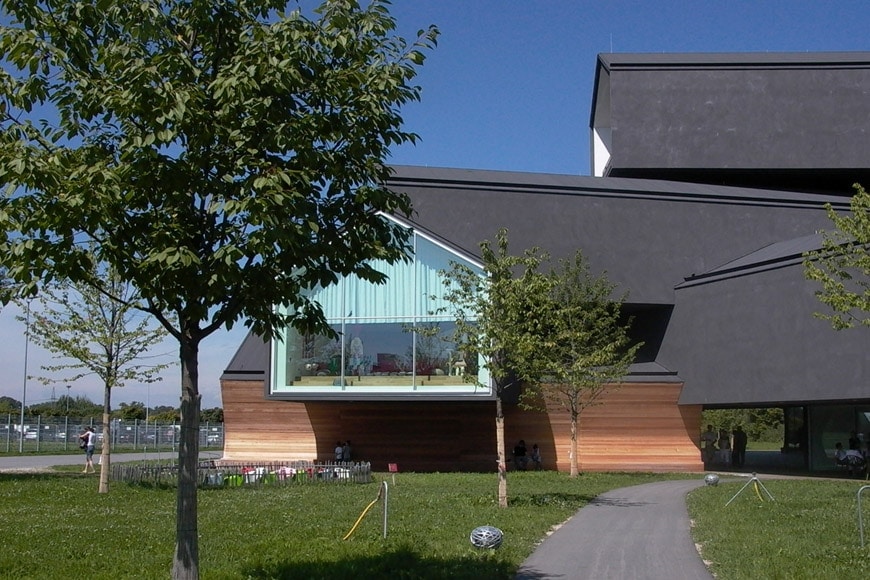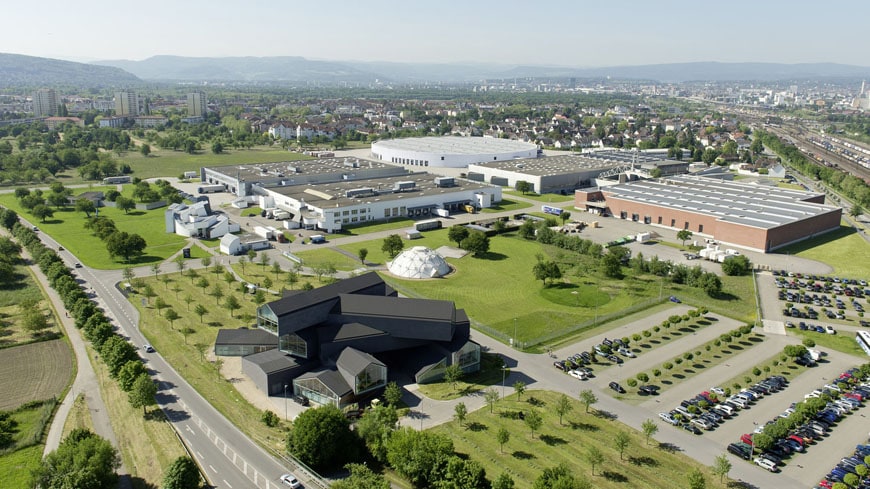Aerial view of the Vitra Campus, courtesy of Vitra
The Vitra Campus in Weil am Rhein | a collection of built architecture
The Vitra Campus is not simply a corporate museum but a unique collection of contemporary architecture, promoted by one of the world’s most prestigious furniture companies and a manufacturer whose name is deeply connected to some of the leading designers of modernity, like Charles and Ray Eames.
Where else you can see, within an area of a few square kilometers, an ensemble of buildings designed throughout 35 years by Zaha Hadid, Tadao Ando, Frank Gehry, Herzog & de Meuron, Sanaa, Alvaro Siza, and Jean Prouvé, to name a few?
The Vitra Campus also represented a place of architectural experimentation; the Fire Station was the first built project by Zaha Hadid and the Conference Pavilion was the first designed by Tadao Ando outside Japan.
Everything at the Campus has an international connotation; from its location, a point on the map of Europe where three countries – Switzerland, France, and Germany – meet, to the famed architects involved in the project, coming from Europe, the United States, and Japan.
A view of the Vitra Haus by Herzog & de Meuron. Foreground: Airstream kiosk, 1968-2011; an original 1968 Airstream trailer, restored and placed at the campus in 2011, is used as a takeaway in Summer. Photo Julien Lanoo, © Vitra (www.vitra.com).
View of the Vitra Campus entrance. Foreground, one of the bus stop shelters designed by Jasper Morrison in 2006; background, the Vitra Design Museum by Frank Gehry, 1989. Photo Inexhibit.
The Vitra Campus’s history is rather recent, it began in 1981 when, after a fire that destroyed a large part of the company’s premises, Vitra decided to hire various contemporary architects to design the new buildings.
The structures built at the Vitra Campus are 16 so far. Production workshops, such as the Factory buildings, designed by Alvaro Siza in 1994 and by Sanaa in 2012; lightweight structures like the Petrol Stations designed by Jean Prouvè in the early fifties, the two bus stations by Jasper Morrison added in 2006 and Diogene, the minimal house designed by Renzo Piano; exhibition venues such as the 1989 Vitra Design Museum by Frank Gehry and the Fire Station by Zaha Hadid, at first built as a firemen’s hall and today used as a space for temporary exhibitions; multi-functional buildings like the poetic Conference pavilion of Tadao Ando and the Vitra Haus, designed by Herzog & de Meuron and completed in 2010.
Building Factory by Alvaro Siza, 1994. Courtesy of Vitra
Dome. After Richard Buckminster Fuller, 1975/2000
The Dome was installed at the Vitra Campus in 2000 and is currently used for temporary exhibitions. Left: Photo courtesy of Vitra. Right: photo Inexhibit.
The Fire Station by Zaha Hadid, 1993. Initially a firemen’s hall, it is now used for temporary exhibitions and special events organized by the Vitra Design Museum.
Up: external view, courtesy of Vitra
Down: external and internal views and view of the terrace. Photos by Inexhibit
View of the Conference Pavilion by Tadao Ando, 1993.
The building, lying alone in the middle of a lawn and arranged on two levels, one under the ground, is the first realized by Tadao Ando outside Japan. During the pavilion design, Ando tried to maintain as many existing trees as possible; but three of them couldn’t be saved, thus their memory” was preserved by impressing some of their leaves on the bare concrete façade of the building. Photos Inexhibit
Vitra Haus, the showroom building of Vitra was completed in 2010 on a design by Herzog & de Meuron. Photos Inexhibit
Jean Prouvé, Petrol Station 1953-2003. Realized in 1953 for Mobil Oil – Socony Vacuum, the Petrol Station is a modular structure made of aluminum sheets and profiles. In 2003 three of them were installed at the Vitra Campus. Photo courtesy of Vitra.
Factory building by Sanaa, 2012. The façade presents a curved shape due to logistic requirements and helps reduce truck movements and maneuvers. Right: a detail of the building envelope. Photos courtesy of Vitra.
“Diogene”, a minimalist house with a surface of 6 square meters only, was conceived by Renzo Piano and realized in 2013. Despite its reduced dimension, “Diogene” is a highly innovative project regarding sustainability and low energy consumption.

